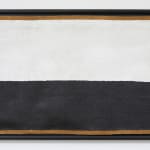






Colin McCahon
1010 x 2320 x 65mm framed
Further images
C. McCAHON 1973 B1 (brushpoint, b.l.)
Of all McCahon’s subjects his landscape paintings are some of his most iconic. The form and content of his early landscapes vary from his later ones; however a unifying theme is the sense of a spirit inherent in the land. McCahon’s landscapes from the late 1960s to mid 1970s equivocate between landscape and pure abstraction. The structure of the land is reduced to its bare essentials, and the colourations to an absolute minimum.
In 1958 McCahon had travelled to America where he no doubt viewed the work of artists such as Mark Rothko and Barnett Newman, whose influences both resonant in B1, painted at the same time as its companion work B2 and the 14-painting series A.
Characteristically absent of people, McCahon’s landscapes communicate a strong sense of the value and the history of the land in isolation. B1 conveys McCahon’s interest and concern for the order and structure of the landscape. The jute’s rough texture takes on the immediacy of the ‘raw land’ McCahon sought to capture, while the expanse of the black-sand beach is condensed into rich black and white bands and speaks of the Muriwai area that inspired and informed McCahon’s work so greatly for many years.
By simplifying the forms and minimising descriptive aspects, he begins to communicate the intrinsic meaning and essence of the land. The representation of light is condensed, and there are no defining lines to emphasise contours of the land as is the case in the “North Otago” series, or weather patterns as in the series titled “Kaipara Flats”.
The contrasted and sectioned areas of land and sky can also be viewed as signifying heaven and earth, life and death, and broader concepts of creation. From the 1940s until his later works of the mid 1980s, religion played a significant role in McCahon’s work. This painting expresses the artist’s ongoing concern with representing both the physical landscape and more universal and spiritual themes.
Provenance
Private Collection, South IslandPrivate Collection, Auckland, New Zealand
Record number: cm001603
Exhibitions
Jet Out from Muriwai: McCahon Paintings and Drawings, Barry Lett Galleries, Auckland, 13 - 24 August 1973
The Group Show [1973], CSA Gallery, Christchurch, 15 - 30 September 1973
Candles in a Dark Room: James K Baxter and Colin McCahon, Auckland City Art Gallery, Auckland, July 1995 - October 1996
Colin McCahon (1919-1987), Art Basel Hong Kong 2018 with Gow Langsford Gallery, 29 - 31 March 2018Colin McCahon: A Journey, 23 November 2024 - 25 January 2025, Gow Langsford Gallery, Auckland, New Zealand





